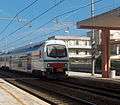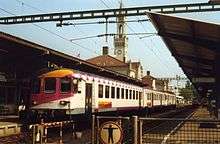Control car
A control car, cab car (in the United States and Canada), control trailer (in Australia and New Zealand), or driving trailer (in United Kingdom, Ireland and Australia) is a generic term for a non-powered railroad (US) or railway (UIC) vehicle that can control operation of a train at the end, opposite to the position of the locomotive. They can be used with diesel or electric motive power, allowing push-pull operation without the use of an additional locomotive. They can also be used with a power car or a railcar. In a few cases control cars were used with steam locomotives, especially in Germany[1] and France (see article Voiture État à 2 étages).
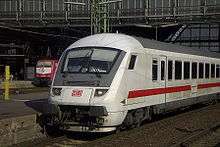
In the United States and Canada, cab cars are control cars similar to regular passenger cars, but with a full driver's compartment built into one or both ends. They can be very similar to regular rail cars, to the point of including a gangway between cars so that they could be used in the middle of a passenger train like a regular car if necessary. European railways have used such equipment since the 1920s. In the United States they appeared for the first time in the 1960s.[2] In the United Kingdom, driving trailers may have one or two driving cabs.
Trains operating with a locomotive at one end and a control car at the other do not require the locomotive to run around to the opposite end of the train when reversing direction at a terminus. Control cars can carry passengers, baggage, mail or a combination thereof, and may, when used together with diesel locomotives, contain an engine-generator set to provide head-end power (HEP).
In addition to the driver's cab, which has all the controls and gauges necessary for remotely operating the locomotive, control cars usually have a horn, whistle, bell, or plough (as appropriate), and all of the lights that would normally be on a locomotive. They must also be fitted with all necessary communication and safety systems like GSM-R or European Train Control System (ETCS).
Control method
The classic control method was a multiple unit cable with jumpers between cars. In North America and Ireland a standard AAR 27-wire cable is used, in other countries cables with up to 61 wires can be found. A more recent method is to control the train through a Time-Division Multiplexed (TDM) connection, which usually works with two (protected) wires.
North America
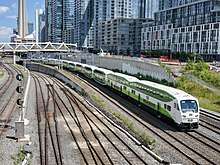
Some commuter rail agencies in the United States routinely use cab cars in place of regular passenger coaches on trains. While older bi-level cab cars often made trains less aerodynamic, new ones being built for GO Transit and Metrolink have specially streamlined cabs. The Chicago and North Western Railway had 42 control cabs built by Pullman-Standard in 1960, which eliminated the need for its trains or locomotives to be turned around.[2] It was an outgrowth of multiple-unit operation that was already common on diesel locomotives of the time. The Canadian transit agency Exo uses control cars on all its trains, except its electric multiple units, which run as double-ended semi-permanently coupled three-car rakes. Amtrak also has a number of ex-Budd Metroliner cab cars, which are used primarily for push pull services on the Keystone Service and New Haven–Springfield Shuttle. The Long Island Rail Road uses cab cars on its C3 double deck coaches.
During the mid-1990s, as push-pull operations became more common in the United States, cab-cars came under criticism[3] for providing less protection to engine crews during level crossing accidents. This has been addressed by providing additional reinforcing in cab cars. This criticism became stronger after the 2005 Glendale train crash, in which a Metrolink train collided with a Jeep Grand Cherokee at a level crossing in California. The train was traveling with its cab car in the front, and the train jackknifed.[4] Eleven people were killed in the accident, and about 180 were injured.
In early 2015, another collision occurred in Oxnard, California, involving one of Metrolink's improved "Rotem" cab cars at the front of the train hitting a truck at a crossing. The truck driver left his vehicle before the impact, but the collision resulted in multiple car derailments, jacknifing, resulting in injury.
Converted locomotives

| Wikimedia Commons has media related to Cab cars of the United States. |
From the 1970s until 1999, the Long Island Rail Road used a number of older locomotives converted to "power packs". The original prime movers were replaced with 600 horsepower (450 kW) engines/generators solely for supplying HEP with the engineer's control stand left intact. Locomotives converted included Alco FA-1s and FA-2s, EMD F7s, and one F9. One FA was further converted into a power car for the C1 bi-level cars in 1991. The railroad has since switched to classic cab cars with a DE30AC/DM30AC locomotive on some trains. Longer trains require two engines, one on each end.[5]
Until the 1980s, Ontario's GO Transit had a similar program for EMD FP7s. They were frequently used with GP40-2Ws and GP40M-2s, which lacked HEP to power trains. They also found use with HEP-equipped GP40TCs and F40PHs, and were sometimes leased to other railroads. They were eventually retired in 1995 upon the arrival of the EMD F59PHs and subsequently scrapped, except for one F7A and one F7B, which were sold to Tri-Rail and the Ontario Northland Railway, respectively.[6]
MARC had a former F7 unit, #7100, also converted into an APCU, or All-Purpose Control Unit, which occasionally substituted for a cab car. It was rebuilt with a HEP generator, newer cab controls, and fitted with a Nathan Airchime K5LA. It was used up until the late 2000s, and was donated to the B&O Railroad Museum in 2010.[7]
Amtrak
Amtrak developed their Non-powered Control Unit (NPCU) by removing the prime mover, main alternator, and traction motors from surplus EMD F40PH locomotives. The control stand was left in place, as were equipment allowing horn, bell, and headlight operation. A floor and roll-up side-doors were then installed to allow for baggage service, leading to the nickname "cab-baggage cars" or "cabbages".
Six NPCUs rebuilt for Cascades service in the Pacific Northwest do not have the roll-up side doors, because the Talgo sets on which they operate have a baggage car as part of the trainset, though #90230 was recently fitted with these doors.
Four NPCUs are used on the Downeaster. These units have Downeaster logos applied to the front and the sides of the units.
Three NPCUs are designated for use on Amtrak California services. They are painted in a paint scheme similar to the old with blue-and-teal striped livery used by Caltrain between 1985 and 1997.
In 2011, Amtrak F40PH 406 was converted to an NPCU to enable push-pull operation of Amtrak's 40th-anniversary exhibit train; in addition a HEP generator was installed to supply auxiliary electricity. Unlike other NPCUs, the 406 retains its original number (instead of being renumbered to 90406) and resembles an operational F40PH externally.[8]
In October 2015, NPCU #90208 was painted into a special Veterans livery similar to P42DC #42 and ACS-64 #642. Later, in August 2016, NPCU #90221 was repainted into the same scheme. Cascades NPCU #90250 was rebuilt with roll up side doors with Amtrak Phase 5 paint and given a Seattle Seahawks wrap, which has since been removed.
In 2017, NCDOT started a Cab Control Unit (CCU) program using ex-GO F59PHs.[9]

 A newer GO Transit BiLevel cab car with full upper cab, in Brampton, Ontario
A newer GO Transit BiLevel cab car with full upper cab, in Brampton, Ontario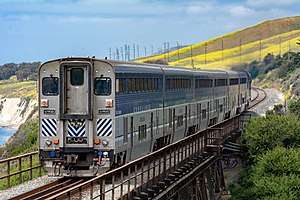 Pacific Surfliner cab car in 2018
Pacific Surfliner cab car in 2018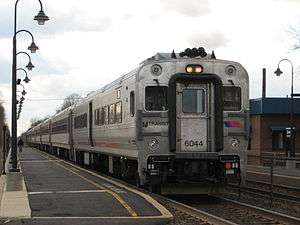 NJ Transit Comet V at Dunellen
NJ Transit Comet V at Dunellen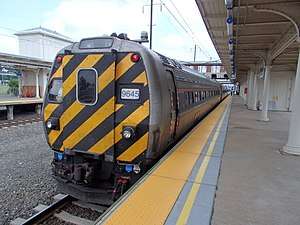 Amtrak 9645 at Lancaster station in August 2017
Amtrak 9645 at Lancaster station in August 2017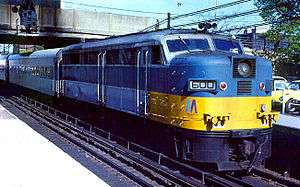 LIRR 600 is an FA-2 converted into a "power pack".
LIRR 600 is an FA-2 converted into a "power pack"..jpg) Go Transit F7A 901, used as a power car
Go Transit F7A 901, used as a power car
Europe
In Britain, this type of car is called a driving trailer. There are many examples of this type of vehicle in operation in Europe.
Austria
| Wikimedia Commons has media related to Driving trailers of Austria. |
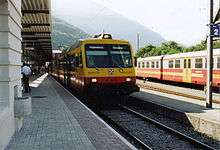
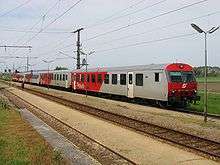 The Steuerwagen of the Austrian CityShuttle in Lower Austria
The Steuerwagen of the Austrian CityShuttle in Lower Austria- CAT Steuerwagen in Mannswörth
Belgium

NMBS/SNCB make extensive use of push-pull operation. Trains are powered by class 21 class 27 or class 18 electric locomotives and are operated in one direction from a driving carriage.
| Wikimedia Commons has media related to Driving railway coaches of Belgium. |
Czech Republic and Slovakia
In the Czech Republic (and the former Czechoslovakia), control cars were hardly used in the past. The main reason was concerns about the greater tendency of trainsets that do not have a traction unit at the head of the train to derail. Earlier legislation considered such a train to be sunk and for this reason the speed of such a train was limited to 30 km / h.
The first attempt to operate control cars at ČSD was the production of two three-car units, each consisting of one SM 487.0 drive car, an inserted N 487.0 car and a Ø 487.0 control car. Both prototypes were produced in 1966 by Tatra Studénka Wagon and MEZ Vsetín. However, the units did not have sufficient capacity and were used to convert to five-car units with motor vehicles series SM 488.0 (now series 560) on the fronts.
 ČD 954.2 series control car at Praha-Dejvice
ČD 954.2 series control car at Praha-Dejvice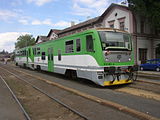
.jpg) The prototype of the 954 series control car at Brno main railway station
The prototype of the 954 series control car at Brno main railway station ČD 954 series control car in Oslavany
ČD 954 series control car in Oslavany.jpg) ČD 961 series control car at Brno-Královo Pole railway station
ČD 961 series control car at Brno-Královo Pole railway station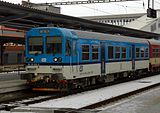 ČD 943 series control car in Ostrava-Kuncice
ČD 943 series control car in Ostrava-Kuncice ZSSK 951 series control car in Kúty
ZSSK 951 series control car in Kúty
Finland
The VR fleet includes 12 cab cars (Finnish: ohjausvaunu), classified as Edo.[10]
France
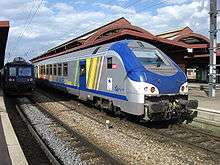
The Corail fleet includes 28 voitures-pilote, classified as B6Dux.
| Wikimedia Commons has media related to Driving railway coaches of France. |
Denmark
The Danish ABs were ordered in 2014. The control car is manufactured by Bombardier. They are to be upgraded for ERTMS, starting 2019.[11]
Germany
The first German attempts to use control cars (German: Steuerwagen) and remote control-equipped steam locomotives were before World War II by the Deutsche Reichsbahn (DRB). The driver's control instructions were transmitted from the control car to the locomotive by a Chadburn-type machine telegraph (similar to engine order telegraphs on ships). The order had to be immediately acknowledged and implemented by the automatic firebox controllers. This indirect control was judged as impractical and unsafe, because, although the driver controlled the brake directly, the danger existed that in an emergency the locomotive would continue supplying "push" power for some time and possibly derail the train.
Attempts to use electric locomotives (beginning with a converted E 04 class model) were more promising, as the engine driver could control the locomotive directly. World War II interrupted the test program, despite good successes. Only after the war would control car operation be slowly accepted, when locomotives and suitably equipped cars became available.
The length of train consists in push-pull operations was originally limited to 10 cars for reasons of guidance dynamics. A speed limit of 120 km/h was also imposed, rising to 140 km/h in 1980. This was not an operational hindrance, as push-pull trains were generally initially used in six-car commuter trains.
Only since the mid-1990s have long-distance trains, which can have up to 14 cars and travel at speeds of 200 km/h, been operated with control cars. A special circumstance is the ICE 2, which may operate with the control car in the lead at up to 250 km/h on the recently built high-speed lines.
| Wikimedia Commons has media related to Driving railway carriages of Germany. |
 ICE2 Steuerwagen at Cologne Bonn Airport
ICE2 Steuerwagen at Cologne Bonn Airport Different livery on a double-decker German Steuerwagen
Different livery on a double-decker German Steuerwagen German InterRegio livery in Heidelberg
German InterRegio livery in Heidelberg Modern German version in an older livery
Modern German version in an older livery Frontal view of the German model
Frontal view of the German model A German commuter train clearly showing the locomotive driving from the rear
A German commuter train clearly showing the locomotive driving from the rear
Hungary
Control cars in Hungary are present since the 1960s. The first type of control cars used by MÁV, that is still used on low traffic branch lines was the BDt (then called BDat) series, with the BDt 100 series being capable of travelling with diesel (and formerly with steam) engines (most notably the M41 series), and the BDt 300 series being capable of travelling with electric V43 series engines. These carriages were built by the MÁV Dunakeszi Main Workshop between 1962 and 1972.[12]
Most of the BDt 100 series, with lack of function after the Bzmot series overtook the shrinking number of unelectrified branch lines, were converted to BDt 400 series by the Dunakeszi Main Workshop, now led by Bombardier, in 2005 (after a prototype series of 7 built in 1999). They are only compatible with the V43 2xxx series, as only they have digital remote control.
With the purchase of the former East German carriage series from the DB, called "Halberstadters", 27 control cars serialed Bybdtee arrived in Hungary. Although a V43 3xxx series was introduced that has special remote control compatible to these control cars, because of the Halberstadters' rare use as branch line carriages, they are rarely used as effective control cars, and are more frequently seen as a regular carriage because of their bicycle storage space.
There are more carriages that are technically separate control cars, like the Bdx series that were part of the (now deleted from rolling stock) MDmot DMU series, or the Bmxt series that is part of the BDVmot and BVhmot EMU series, but they are considered and treated as a part of their DMU and EMU unit respectively.
 Control car MÁV BDt 322, still the series of control cars with the largest active number in Hungary, now mainly used on electrified rural lines
Control car MÁV BDt 322, still the series of control cars with the largest active number in Hungary, now mainly used on electrified rural lines Prototype control car MÁV BDt 405 in its original, grey-yellow-blue livery (now repainted to the fleet color visible on the carriage behind)
Prototype control car MÁV BDt 405 in its original, grey-yellow-blue livery (now repainted to the fleet color visible on the carriage behind) Control car MÁV BDt 406, the most recent control car used on lines surrounding Budapest
Control car MÁV BDt 406, the most recent control car used on lines surrounding Budapest MÁV Bybdtee series, used rarely as an actual control car
MÁV Bybdtee series, used rarely as an actual control car
Ireland
Iarnród Éireann operates two classes of push-pull trainsets, each with its own Control Car:
- De Dietrich (Enterprise service) with driving cab containing EMD control stand, luggage compartment and passenger seating. On this set, train heating was supplied from the locomotive Head End Power System, but this led to reliability issues on the 201 Class locomotives, so Mark 3 Generator vans have replaced one of the De Dietrich standard class coaches in the formation since September 2012.
- Numbered 9001–9004
- CAF (Mark 4) with driving cab containing replica locomotive control stand, luggage compartment and twin engine / generator sets for train heating. No passenger seating is provided.
- Numbered 4001–4008
All Mark 4 Control Cars have full-sized driving cabs with EMD locomotive type power and brake controls. Locomotive control is by means of an AAR system, modified by Iarnród Éireann (IÉ) to include control of train doors and operate with 201 Class locomotives.
Iarnród Éireann formerly operated Mark 3 Control Cars from 1989 until 2009:
- Mark 3s with driving cab containing replica locomotive control stand, luggage compartment, underslung Cummins engine / generator set for train heating and passenger seating.
- Numbered 6101–6105, converted from Mark 3 InterCity cars for suburban push-pull services. These were withdrawn in September 2009 following the introduction of 22000 Class InterCity Railcars. These units have since been scrapped apart from 6105 which has been preserved by the West Clare Railway.
| Wikimedia Commons has media related to Driving railway carriages of Ireland. |
Italy
In Italy, the first push-pull trains began to run after World War II.
At the time there were no systems to actually remote command the rear locomotive, so an engineer had to take place in it and command traction, following instructions (via an apposite intercom) given by the other driver, who remained in the front car, commanding brakes and sighting signals. This lasted until the adoption of the 78-wire cable in the 1970s, which enabled full remote commanding from control cars.
Today push-pull trains are very common, and different kinds of control cars are employed:
- UIC Z1 control cars.
- MDVC type control cars, with aerodynamic or communicating cabin.
- Piano ribassato type control cars, with flat, refurbished E464-like or communicating cabin.
- Doppio Piano two floors control cars.
- UIC-X type control cars.
- Vivalto type control car.
These types allow full remote control of any Italian locomotive supplied with standard 78-wire cable, except for UIC Z1, which are used on IC services and are only able to command class E.402 locomotives, and MDVC Diesel-specific version, usable only with class D.445 Diesel locomotives.
The same driving commands are used for both rheostatic and electronic locomotives, but their meanings change.
Vivalto type control cars, at this time, can only remote command Class E.464 and Class E.632 locomotives, because of software issues, though are able to command other locomotive types. Vivalto cars can also use TCN remote control cable.
Driving cars can be recognized because of the "np" in their identification number and usually also have a dedicated compartment for bicycle and luggage transportation.
There also are specific EMU/DMU non-motorized units control cars, which (in Trenitalia) are classified as Le / Ln XXX with no significant difference between them and motorized units except the lack of traction motors.
| Wikimedia Commons has media related to Driving railway carriages of Italy. |
The Netherlands
| Wikimedia Commons has media related to Driving railway coaches of the Netherlands. |
NS use their driving carriages (Dutch: Stuurstandrijtuig) in two different strategies.
For short-distance trains they use a "virtual EMU" concept. Train sets are formed of a driving carriage, two or three intermediate carriages and either a class 1700 electric locomotive or an EMU motor vehicle (i.e. NS DD-AR). These train sets are diagrammed as if they were all EMUs resulting in formations with two locomotives, often at intermediate positions in the train.
For longer distance workings, including the Benelux services to Brussels the more normal mode of operation is used.
Poland
| Wikimedia Commons has media related to Bombardier Twindexx of Koleje Mazowieckie. |
In Poland, the term used is "wagon sterowniczy", which literally means "control carriage".
Koleje Mazowieckie use driving trailers on their regional services. The first batch of double-decker driving trailers and cars, the Twindexx Bombardier Double-deck Coaches, was delivered in 2008.[13] The second batch, PESA-made Sundecks, was delivered at the end of 2015.[14]
Switzerland
Swiss driving trailers operate in many different configurations. There are several models currently in service on S-Bahn networks as well as regional, InterRegio, and InterCity services. These are operated by the federal railway system (SBB) as well as various private railroads throughout the country (including narrow gauge lines) and into France, Germany, and Italy.
Driving trailers are classified after the UIC-lettering system, adding a "t,” giving Bt (second class), BDt (second class + baggage), ABt (first + second class), or Dt (baggage).
For Intercity trains there are the Bt IC that work together with EW IV and the double-deck version for the IC 2000 trainsets, working with Re 460.
The Zürich S-Bahn trainsets with Re 450 work in fix consists of Re 450 - B - AB - Bt but intermediate cars and driving trailers are numbered as coaching stock.
"NPZ" Regional and S-Bahn trains with RBDe 560 usually have a matching Bt driving trailer. Replacement by an older BDt EW I/II is technically possible. Older driving trailers, mostly BDt EW I/II and a few remaining Dt of SBB can be used with Re 420 and RBe 540 and some motive power of private railways. In theory also Re 430 and Re 620 can be controlled but these classes only work freight trains today.
The BLS operates four groups of driving trailers:
- ABt NPZ to go with RBDe 565 and RBDe 566 II (ex RM)
- Bt EW I 950-953, BDt 940-941, car-shuttle BDt 942-945, 946-949 and 939 can work with Re 425, Ae 4/4 and Re 465
- Bt EW III, BDt EW II (both ex SBB), Bt EW I 901-902 (ex Thurbo/MThB) and leased Dt from SBB can work with Re 420.5 ex SBB and BLS Re 465.
- Bt EW I 950–953, BDt 940–941, car-shuttle BDt 942–945, 946-949 and 939 can work with Re 425, Ae 4/4 and Re 465
Südostbahn had a fleet of ABt for their BDe 4/4 but they will soon be fully replaced by FLIRTs. NPZ ABt exist for the two types of RBDe 566 SOB owns (566 071-076 ex BT and 566 077-080 ex SOB of the SBB-type). Nine BDt are used for the Voralpen-Express with Re 456, Re 446 or SBB-CFF-FFS Re 420.
The narrow gauge Zentralbahn ABt can control HGe 101 (ex SBB), De 110, BDeh 140 (ex LSE) and the new "SPATZ" ABe 130.
The Rhaetian Railway (RhB) has, besides the ABDt that work with Be 4/4 511-516, a group of driving trailers that can be used with their Ge 4/4 I, II and III locomotives. Three of them are specially fitted for Vereina car shuttle trains.
The Matterhorn-Gotthard-Bahn (MGB) has numerous driving trailers for almost all types of motive power. They work regional trains and car shuttle trains through the Furka Base Tunnel.
| Wikimedia Commons has media related to Driving trailers of Switzerland. |
United Kingdom
Control cars have been in use in the United Kingdom for many decades, with the Great Western Railway often using autocoaches on branch line services. These allowed a train driver to remotely control the regulator and reverser of a suitably equipped locomotive. The fireman remained on the locomotive to operate the boiler and locomotive whistle. Locomotives were commonly sandwiched between a pair of autocoaches, allowing a maximum of four to be used.
Driving Brake Standard Open
A Driving Brake Standard Open or DBSO is a specially converted Mark 2 passenger car. Initially operated by ScotRail from 1979, they were operated on InterCity and Anglia Railways services on the Great Eastern Main Line from the late-1980s until 2006. Some have been refurbished for use on Network Rail test trains. Others were used by Direct Rail Services on Cumbrian Coast line locomotive hauled passenger trains under contract to Northern Rail until late 2018 when they were replaced by regular Diesel multiple units.[15]
 DBSO in Anglia Railways livery
DBSO in Anglia Railways livery
Driving Van Trailer
A Driving Van Trailer or DVT is a more modern type of control car, purpose-built to include space for baggage and a guard's office. The DVT was developed in the late-1980s from the DBSO and designed to be used with Mark 3s on West Coast Main Line services and Mark 4s on the East Coast Main Line. As at December 2019, Mark 3 DVTs are in service with Chiltern Railways, Greater Anglia, Network Rail and Transport for Wales, with Mark 4 DVTs in service with London North Eastern Railway with some to be operated by Transport for Wales from 2020. Former operators of the Mark 3 DVTs are Arriva Trains Wales, Virgin Trains West Coast and Wrexham & Shropshire.
| Wikimedia Commons has media related to Driving railway carriages of the United Kingdom. |
- Wrexham & Shropshire Mark 3 DVT at Marylebone station

Oceania
Australia
NSW
All of the driving trailers are generally on much of the earlier rolling stock. Examples of these driving trailers were on some old (now most likely scrapped) red rattler cars along with C and K sets (4 trailers). The driving trailers from the K set were later converted to ordinary trailers. These can be noted by the positioning of the pantograph. On a single set the pantographs are placed on the second and third cars, and on an eight car train (2 sets combined) they're placed on the second, third, sixth and seventh cars. Some third Generation of Sydney Trains, Tangaras or T sets, have driving trailers but are equipped to supply electricity to the train though the use of a pantograph.
Waratahs (A sets) have two driving trailers (one at each end) with power trailers in between the driving and non-driving trailers.
South Australia
2100 class railcar are driving trailers, being placed in a 2-car consist with a 2000 class power unit, sometimes with a second trailer to make a 3-car consist-the power car would be placed in between the two trailers. As of 2018, only three of these trailers exist, the rest were scrapped. Two are preserved and one that was donated to South Australian Metropolitan Fire Service (cut-in half). Three 2000 class power units out of the twelve have had the same fate.
New Zealand
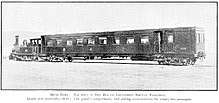
Experiments with light railcars were aimed at cutting costs on lightly-used branch lines.[17] Autotrains were built in 1906[18] and 1907[19] and by 1925 NZR had 8 88-seat and 5 72-seat motor trains.[20] In 1908 there was a motor train Auckland suburban service to Otahuhu[21] and between Morrinsville and Putaruru in 1913.[22]
In Auckland, Transdev Auckland operated 21 DC class locomotives and four DFT class locomotives (owned by KiwiRail) in push-pull mode with 24 sets of 3-5 SA cars and an SD driving car with driving cab and remote controls (ex British Rail Mark 2 carriages rebuilt for suburban service), owned by Auckland Transport.[23] The carriages were replaced with EMUs in July 2015.
Asia
Sri Lanka

Control cars are available on most Diesel multiple units operated by Sri Lanka Railways.
Israel
Control cars are available on most Diesel multiple units operated by Israel Railways.
See also
References
- see German Wiki de:Doppelstock-Stromlinien-Wendezug der LBE
- Phillips, Dave (September 1999). "C&NW Gallery Cars". Rail & Wire. Illinois Railway Museum. Archived from the original on February 16, 2009. Retrieved January 6, 2010.
- Criticism of 'push' trains is on the wrong track, LA Times
- Kim, Victoria (October 14, 2009). "Metrolink pays $30 million to settle most cases in 2005 train crash". Los Angeles Times. Retrieved June 29, 2011.
- http://www.trainsarefun.com/lirr/lirrFA/lirrFA.htm
- https://transit.toronto.on.ca/regional/2506.shtml
- "The MARC 7100 Returns! (November 1999 CSX Railfan Magazine)". TrainWeb. Retrieved September 1, 2012.
- "Exhibit Train Equipment History". Amtrak. Retrieved August 6, 2016.
- https://www.thedieselshop.us/NCDOT.HTML
- http://vaunut.org/kuvat/?tag0=7%7CEdo%7C
- See section 4.2.5, Statusrapport til forligskredsen media november 2018
- http://iho.hu/blogpost/ingavonatok-a-mav-halozatan-i-resz-130215
- "Wagony piętrowe sterownicze (Double-decker driving vans)". Koleje Mazowieckie (in Polish).
- "Wszystkie wagony piętrowe Sundeck i lokomotywy Gama odebrane przez KM (All Sundeck bilevel cars and Gama locomotives delivered to KM)". Rynek Kolejowy (in Polish). 30 December 2015.
- Harry Sedgwick (2017-10-30), The DBSO and Class 37 DRS with Northern Rail departs at Carlisle ahead on Cumbrian Coast Line., retrieved 2019-07-11
- "D Class steam locomotive NZR no 197 at Lower Hutt Railway Station, 1906". natlib.govt.nz. 1906-01-01. Retrieved 2018-05-10.
- "AtoJs Online — Appendix to the Journals of the House of Representatives — 1926 Session I — D-02 Page 11". atojs.natlib.govt.nz. Retrieved 2018-05-10.
- "Appendix to the Journals of the House of Representatives | 1906 Session II". paperspast.natlib.govt.nz. Retrieved 2018-05-10.
- New Zealand Graphic (20 April 1907). "Interior of the new motor train just turned out of the Newmarket workshops". www.aucklandcity.govt.nz. Retrieved 2018-05-10.
- "Appendix to the Journals of the House of Representatives | 1925 Session I". paperspast.natlib.govt.nz. Retrieved 2018-05-10.
- "The Otahuhu Motor Train Service". New Zealand Herald. 1908-10-08. p. 8. Retrieved 2018-05-10.
- "AtoJs Online — Appendix to the Journals of the House of Representatives — 1913 Session I — D-02 Page 2". atojs.natlib.govt.nz. Retrieved 2018-05-10.
- "Ticket to Ride" e.nz magazine, July/August 2007 Volume 8/4, pages 24-28



